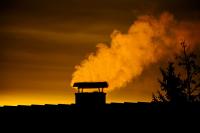Eco-pea coal is not ecological - the findings of researchers from the Warsaw University of Technology

The research was carried out by a team from the Faculty of Building Services, Hydro and Environmental Engineering of the Warsaw University of Technology, the Faculty of Power and Aeronautical Engineering of the Warsaw University of Technology and the The Main School of Fire Service
The standards of total inhalable dust in the exhaust gases are exceeded many times over, the concentrations of carbon monoxide and nitrogen oxides are significantly exceeded, the emission of carcinogenic benzo (a) pyrene - these are the main findings of the research on eco-pea coal, which was carried out by a team supervised by Artur Badyda, PhD, DSc Associate Professor at Warsaw University of Technology, Faculty of Building Services, Hydro and Environmental Engineering.
The researchers tested eco-pea coal of two popular and easily available brands. For their tests, they used an ecodesign-certified boiler, which meets the most restrictive regulations on solid fuel boilers.
The test was carried out in six series of measurements (approx. 90 minutes each). They differed in the parameters of the boiler regulation, in particular with regard to the value of the excess air coefficient, i.e. the amount of air supplied to the combustion chamber.
- ‘When planning and then implementing the research process, during the test we took utmost care to best reflect the actual conditions in which fuels are burned in eco-pea coal boilers’ - explains Artur Badyda, PhD, DSc - the head of the research team.
Standards exceeded
Researchers checked the concentration of total inhalable dust in the exhaust gases. Values from 70 to even 1739 mg / m3 (and they can be even higher) were obtained in the measurement series. The limit value, however, is 40 mg / m3.
Moreover, it was found that the concentrations of PM2.5 in the boiler room were higher than those in the air outdoors.
The researchers found polycyclic aromatic hydrocarbons (PAHs) in the dust samples, including the carcinogenic benzo (a) pyrene.
- ‘Compounds from the group of polycyclic aromatic hydrocarbons (PAHs), as a rule, should not be present in the atmosphere at all due to their high potential for being harmful to human health and life, but the combustion of solid fuels in domestic heating devices is the main cause of emissions of this pollution’ - points out Artur Badyda, PhD, DSc.
The researchers also identified significant exceedance of the concentrations of carbon monoxide (from 1,300 to over 3,000 mg / Nm3, where the standard value equals 500 mg / Nm3) and nitrogen oxides (from 420 to over 600 mg, where the standard value equals 350 mg / Nm3).
Parameters that do not match the declarations
The team also commissioned an evaluation of the quality parameters of both tested eco-peas. The samples were tested by the Fuel Analysis Research Laboratory of the Institute of Power Engineering. It turned out that one of the two tested eco-peas did not meet the parameters declared by the manufacturer: the ash content was more than twice as high (almost 15% instead of 7%), and the calorific value was lower by almost 2 MJ / kg.
- ‘High ash content means that less energy is obtained from the same amount of fuel than could be expected’ - Artur Badyda, PhD, DSc. - ‘The high ash content in the fuel also contributes to an increase in the concentration of dust emitted to the air.’
The research and the report were carried out by: Artur Badyda, PhD, DSc Associate Professor at Warsaw University of Technology, Faculty of Building Services, Hydro and Environmental Engineering. – research coordinator, Piotr Krawczyk, PhD, DSc Associate Professor at Warsaw University of Technology (Faculty of Power and Aeronautical Engineering of Warsaw University of Technology), Jan Bihałowicz, MSc. (the Main School of Fire Service) and Piotr Kępa, MSc. (Faculty of Building Services, Hydro and Environmental Engineering of Warsaw University of Technology).







